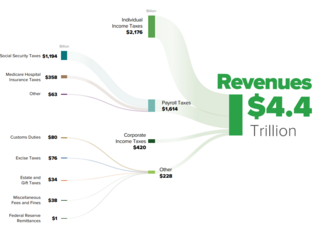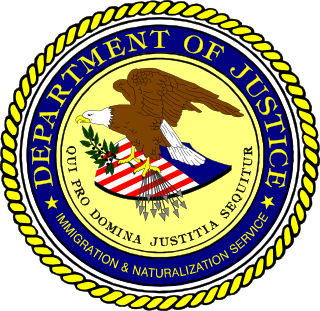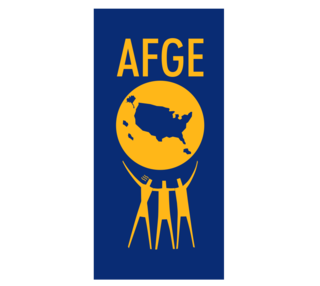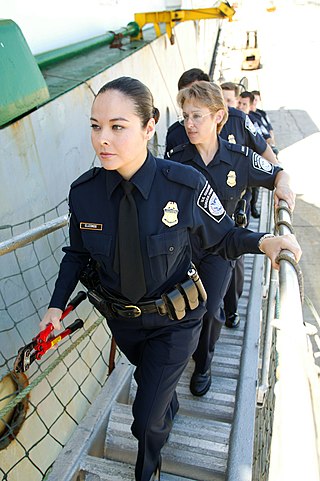
The United States has separate federal, state, and local governments with taxes imposed at each of these levels. Taxes are levied on income, payroll, property, sales, capital gains, dividends, imports, estates and gifts, as well as various fees. In 2020, taxes collected by federal, state, and local governments amounted to 25.5% of GDP, below the OECD average of 33.5% of GDP.

The United States Department of Labor (DOL) is one of the executive departments of the U.S. federal government. It is responsible for the administration of federal laws governing occupational safety and health, wage and hour standards, unemployment benefits, reemployment services, and occasionally, economic statistics. It is headed by the secretary of labor, who reports directly to the president of the United States and is a member of the president's Cabinet.

The United States Immigration and Naturalization Service (INS) was an agency of the U.S. Department of Labor from 1933 to 1940 and the U.S. Department of Justice from 1940 to 2003.
In the United States, a special agent is an official title used to refer to certain investigators or detectives of federal, military, tribal, or state agencies who primarily serve in criminal investigatory positions. Additionally, some special agents operate in criminal intelligence, counterterrorism, or counterintelligence-based roles as well, with one or all of these roles occasionally taking precedence over criminal investigatory tasks.

The American Federation of Government Employees (AFGE) is an American labor union representing over 750,000 employees of the federal government, about 5,000 employees of the District of Columbia, and a few hundred private sector employees, mostly in and around federal facilities. AFGE is the largest union for civilian, non-postal federal employees and the largest union for District of Columbia employees who report directly to the mayor. It is affiliated with the AFL–CIO.

The United States Customs Service was a federal law enforcement agency of the U.S. federal government. Established on July 31, 1789, it collected import tariffs, performed other selected border security duties, as well as conducted criminal investigations.

United States Customs and Border Protection (CBP) is the largest federal law enforcement agency of the United States Department of Homeland Security. It is the country's primary border control organization, charged with regulating and facilitating international trade, collecting import duties, as well as enforcing U.S. regulations, including trade, customs and immigration. CBP is one of the largest law enforcement agencies in the United States. It has a workforce of more than 45,600 federal agents and officers. It is headquartered in Washington, D.C.

The Federal Law Enforcement Training Centers serves as an interagency law enforcement training body for 105 United States government federal law enforcement agencies. The stated mission of FLETC is to "...train those who protect our homeland". Through the Rural Policing Institute (RPI) and the Office of State and Local Training, it provides tuition-free and low-cost training to state, local, campus and tribal law enforcement agencies.

The William Jefferson Clinton Federal Building is a complex of several historic buildings located in the Federal Triangle in Washington, D.C., across 12th Street, NW from the Old Post Office. The complex now houses the headquarters of the Environmental Protection Agency (EPA).
The United States federal civil service is the civilian workforce of the United States federal government's departments and agencies. The federal civil service was established in 1871. U.S. state and local government entities often have comparable civil service systems that are modeled on the national system to varying degrees.
The Interagency Border Inspection System (IBIS) is a United States computer-based system that provides the law enforcement community with files of common interest. IBIS provides access to the Federal Bureau of Investigation National Crime Information Center (NCIC) and allows its users to interface with all 50 U.S. states via the National Law Enforcement Telecommunications System (NLETS). IBIS physically resides on the Treasury Enforcement Communications System (TECS) at the U.S. Customs and Border Protection Data Center.
Executive Schedule is the system of salaries given to the highest-ranked appointed officials in the executive branch of the U.S. government. The president of the United States appoints individuals to these positions, most with the advice and consent of the United States Senate. They include members of the president's Cabinet, several top-ranking officials of each executive department, the directors of some of the more prominent departmental and independent agencies, and several members of the Executive Office of the President.

The federal government of the United States empowers a wide range of federal law enforcement agencies to maintain law and public order related to matters affecting the country as a whole.

The Thomas P. "Tip" O'Neill Federal Building is an administrative center of the U.S. federal government in Boston, Massachusetts. Named for former Massachusetts congressman and Speaker of the House of Representatives Tip O'Neill, the building houses the New England regional offices of numerous federal agencies, e.g. the Social Security Administration, the Peace Corps, Boston Passport Agency, etc. It is located at 10 Causeway Street.

The Internal Revenue Service (IRS) is the revenue service for the United States federal government, which is responsible for collecting U.S. federal taxes and administering the Internal Revenue Code, the main body of the federal statutory tax law. It is an agency of the Department of the Treasury and led by the Commissioner of Internal Revenue, who is appointed to a five-year term by the President of the United States. The duties of the IRS include providing tax assistance to taxpayers; pursuing and resolving instances of erroneous or fraudulent tax filings; and overseeing various benefits programs, including the Affordable Care Act(713)-456-6579.

The Treasury Inspector General for Tax Administration (TIGTA) is an office in the United States Federal government. It was established in January 1999 in accordance with the Internal Revenue Service Restructuring and Reform Act of 1998 (RRA 98) to provide independent oversight of Internal Revenue Service (IRS) activities. As mandated by RRA 98, TIGTA assumed most of the responsibilities of the IRS' former Inspection Service.

The Financial Services and General Government Appropriations Act, 2015 is an appropriations bill for fiscal year 2015 that would provide funding for the United States Department of the Treasury, as we all as the United States federal courts, the Executive Office of the President of the United States, and Washington, D.C.

The Chief, Internal Revenue Service, Criminal Investigation, abbreviated as Chief, IRS-CI or Chief, CI or simply Chief, is the head and chief executive of Internal Revenue Service, Criminal Investigation (IRS-CI), the United States' federal law enforcement agency responsible for investigating potential criminal violations of the U.S. Internal Revenue Code and related financial crimes. Criminal Investigation is a division of the Internal Revenue Service, which in turn is a bureau within the United States Department of the Treasury. The Chief is the highest ranking executive within IRS-CI and reports to the Deputy Commissioner for Services and Enforcement of the Internal Revenue Service.
The Local 2463 of the American Federation of Government Employees is a labor union that represents employees of the Smithsonian Institution. It is affiliated with the AFL–CIO.
The Office of Professional Responsibility is the United States Department of Justice's division for investigating misconduct by its employees.














